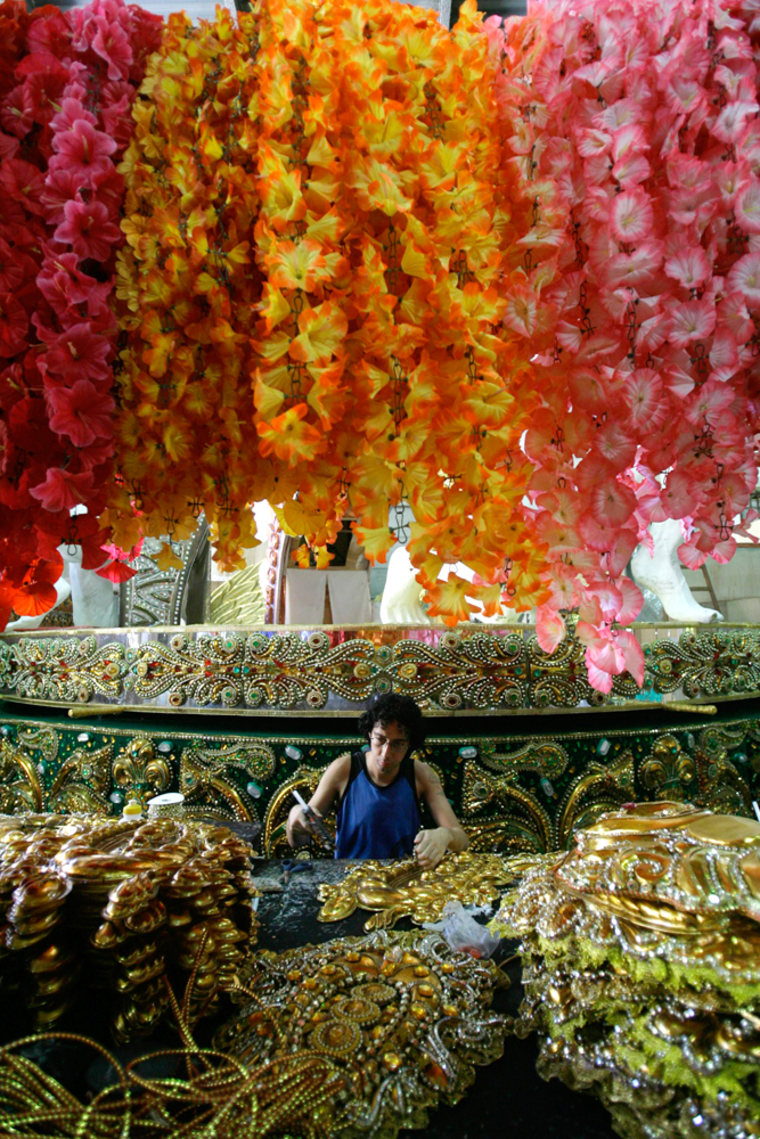Tourists in the know have begun flowing in to Brazil to see preparations for the Feb. 3-4 Carnival parade, but the real work has been in full swing for six months already, transforming Rio's humble shantytowns into riots of color and song.
In the Mangueira shantytown, a grim collection of hovels tumbling along the steep slopes behind Rio's mountaintop Christ the Redeemer statue, drug dealers toting automatic weapons have melted behind a sea of beer vendors, T-shirt hawkers and makeshift barbecue stands, all set up to greet hordes of visitors who wouldn't dare set foot in the slum any other time of year.
They come to watch rehearsals by Mangueira, one of Rio de Janeiro's most traditional samba groups, known here as schools.
Each year, the group spends over $1 million to mount a single 80-minute-long carnival parade featuring 4,500 drummers and dancers in the Sambadrome stadium.
And as the carnival parade date approaches, the group's colors of pink and green cover the shantytown's narrow alleys and exposed brick dwellings. Elaborate glitter-encrusted costumes hang in the windows, and little children, covered in glitter, run around banging on tambourines.
"It's one big factory," explains Max Lopes, Mangueira's carnival designer. "The community plays a big part because of all their love for the school. Everyone's part of the team."
Carnival is a big business in Rio de Janeiro's shantytowns, which are home to the city's 12 top-tier schools and the dozens of others that parade in samba's second and third divisions.
Each year, the schools employ thousands of seamstresses, painters, designers and musicians along with small armies of muscle-bound men to push around the huge floats.
"It totally transforms the community, everybody is working, rehearsing until carnival time. It gives work to unemployed people like me," said Luiz Henrique Barbosa, spends 10 hours a day six days a week making pom-poms for the costumes. "After carnival everything is just dead for six months."
Some of the more skilled artisans actually find work after carnival building sets and doing costumes for Brazil's popular telenovelas. Less skilled workers have to fend for themselves.
"For me it's total 18 to 20 hours days. It's so intense I need to take the rest of the year off," said Aurea Carvalho, 33, who has worked constructing carnival costumes known as "fantasias" for the past 12 years.
Carvalho employs 11 seamstresses, and a night shift was being added in order to have 100 costumes ready in time for the parade.
"It's a big mess, but it's a delicious mess. We talk into the night and get up to date on all the gossip," she says.
Carvalho's costumes will sell for $400 each and provide the buyer with right to dance in the Samba parade, which looks like a lot of fun but is actually a hard-fought competition. A single costume flaw can doom a school's chances of victory as each group tries to wow a panel of judges and become carnival champion.
Winning brings little more than bragging rights, and yet in the poor communities residents throw themselves into carnival preparations as if nothing else matters.
With such high stakes, the carnival industry is becoming more professional every year. More of the complicated tasks such as lighting and special effects are now farmed out to private companies.
And while many samba schools have been funded by criminals who run Rio's hugely popular illegal numbers games, Brazilian corporations increasingly bankroll the samba schools. Costumes and rehearsal tickets pay for the rest.
Mangueira itself has long been plagued by rumors their parade was funded by drug money, a suspicion that appeared to be gain credence after police said Jan. 10 that they were searching for Francisco Paulo Testas Monteiro, the composer of the carnival song for this year's parade, in connection with drug trafficking.
Earlier in the week, police raided the Mangueira shantytown arresting four suspects in the raid and seizing a ton of marijuana. Mangueira has denied any connection to the drug trade.
Tourists can see floats being built at the City of Samba, a $50 million center opened by the city in 2006, with workshops for all the top-tier schools.
But most of the costumes are still produced in shantytown communities, where the "wing presidents" are responsible for their construction and sales.
"We do it out of love. But you need more than just love, because we can't risk looking amateur," explains wing president Amarildo Wanzerler, who doubles as a high-school teacher for prison inmates. "The carnival designer launches the idea and we have to run after it."
This year's design required Wanzerler to come up with 4,500 pom-poms, 3,000 plastic jewels, 3,000 feet of plastic gold chain, 2,000 feet each of green and white cloth, 1,000 feet of gold lame, 30 half-gallon cans of shoemaker's glue, and 220 pounds of glue sticks.
And topping Wanzerler's shopping list was 55 pounds of feathers — a mere pittance by carnival standards.
"It keeps getting more expensive because it's all done by hand, you can't knock off costumes like these with a machine," he says pointing to an elaborate pom-pom-lined headdress and winglike shoulders sprouting a gilded angel on one side.
At the City of Samba, hundreds of workers are busy building and painting huge floats featuring a herd of wild elephants, three-headed dragons and even a miniature recreation of the Mangueira shantytown.
In a corner, three English women who don't speak Portuguese work quietly with their glue guns alongside the shantytown residents as part of a volunteer for work abroad program.
"I've learned they use a lot of glue!" said Fiona Montgomery, 22, "There's so much detail that goes into everything, all this detail that you don't even notice. It's amazing, all this work is for something that's only going to be used for one single day."
